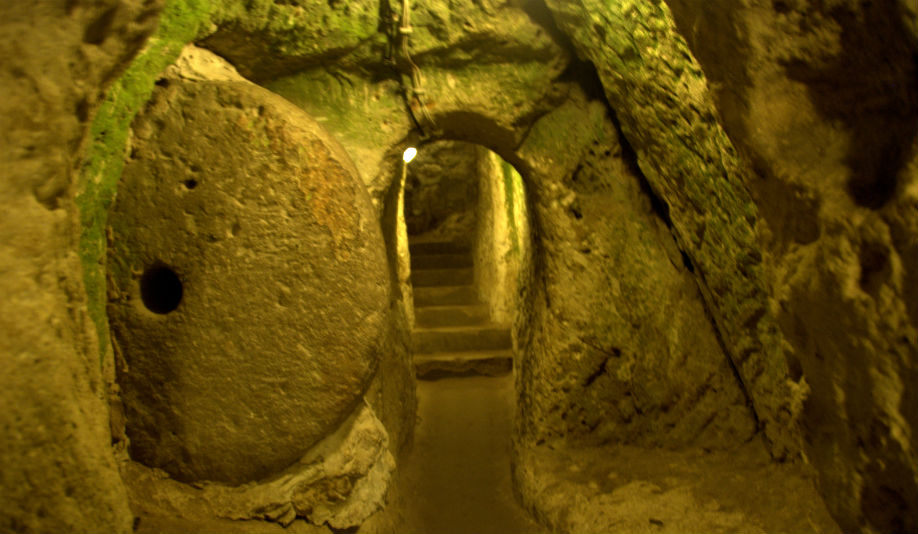Derinkuyu Underground City is an ancient multi-level underground city of the Median Empire in the Derinkuyu district in Nevşehir Province, Turkey.
Extending to a depth of approximately 60 m, it was large enough to shelter approximately 20,000 people together with their livestock and food stores.
It is the largest excavated underground city in Turkey and is one of several underground complexes found across Cappadocia.

One of the heavy stone doors. They have a height of 1–1,5 m, 30–50 cm in width and weigh 200–500 kg. The hole in the centre can be used to open or close the millstone, or to see who is outside.
It was opened to visitors in 1969 and to date, about half of the underground city is accessible to tourists. The underground city at Derinkuyu could be closed from the inside with large stone doors. Each floor could be closed off separately.
The city could accommodate up to 20,000 people and had all the usual amenities found in other underground complexes across Cappadocia, such as wine and oil presses, stables, cellars, storage rooms, refectories, and chapels. Unique to the Derinkuyu complex and located on the second floor is a spacious room with a barrel vaulted ceiling. It has been reported that this room was used as a religious school and the rooms to the left were studies.
Between the third and fourth levels is a vertical staircase. This passage way leads to a cruciform church on the lowest (fifth) level.
The large 55 m ventilation shaft appears to have been used as a well. The shaft also provided water to both the villagers above and, if the outside world was not accessible, to those in hiding.
History
First built in the soft volcanic rock of the Cappadocia region, possibly by the Phrygians in the 8th–7th centuries B.C according to the Turkish Department of Culture, the underground city at Derinkuyu may have been enlarged in the Byzantine era. During the Persian Achaemenid empire the city was used as a refugee settlement. There are references to underground refugee settlements built by the Persian king Yima in the second chapter of the Zoroastrian book Vendidad. Therefore many scholars believe that the city may have been built by the Persians. The city was connected with other underground cities through miles of tunnels.
Some artifacts discovered in these underground settlements belong to the Middle Byzantine Period, between the 5th and the 10th centuries A.D. It is speculated that the number of underground settlements, generally used for taking refuge and for religious purposes, increased during this era.
Derinkuyu Underground City, Cappadocia,





For the hıstory buffs and photographers thıs entıre area wıth ıts unıque landscape ıs just astoundıng! Be ready to take plenty of photos and hope for a blue sky. Thıs ıs one of my favourıte stops ın the whole country. There are also a number of small shops sellıng everythıng from trınkets to honey.
When passing through Derinkuyu on your way to Goreme be sure to take a tour through the underground city that consists of carved out dwellings (some over seven levels). These underground dwellings were only discovered about thirty years ago and they are believed to date back to 2000BC. The city was able to support the towns folk and their animals…
Some of the carved-out cathedrals are fairly intricate. I would highly recommend visiting Cappadocia. This site is extremely well-preserved. These underground caves would be especially interesting for older children to visit, as it might spark their interest in history and the habits of people from the past.
It was sobering to learn that Christians lived in the Underground city mostly in the dark with animals present to be protected from the persecutors. There is a nice souvenier shop on site.
Atmosphere and offers a natural history documentary history. If you want to find a hidden treasure is enough to see Capadoccia. If you want to know the culture of Cappadocia door wide open. Capadoccia see the need to recognize the world. Cappadocia, Turkey and the world's most reliable and amazing place.
I didn't give this 3 stars because anything was necessarily wrong, it just wasn't my cup of tea. If you're amazed that people lived in caves a thousand, (or however long) ago, you'll dig it.
But if you are a little older you can still experience something truly special, just take a few precautions. A small flashlight may help you to see some steps a little better.
Do not take a big backpack filled with extra cloths, a small water bottle could be more valuable. The temperature may be cold, but walking the narrow tunnels…
This trip is usually included on tours leaving Goreme. It usually crowded and the entrance is controlled. Some places (sometimes long stairs) are made for just one pearson each time.
Do not go if you have any kind of claustrophobic problems.
I've heard about the caves a lot before actually visiting Cappadocia. The landscape was magical, one cannot believe that the caves are not man made. This attraction is certainly recommended for all those who want to embrace mother nature and see the way of living of early settlers.
The clay from the Red River is spun and shaped into all sorts of items. You can get all of them cheaper outside of Avanos!